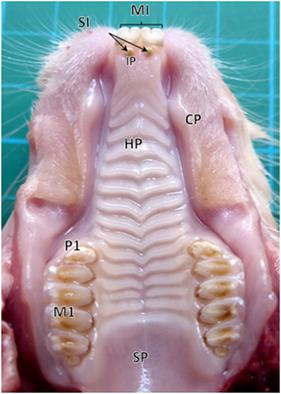当前位置:
X-MOL 学术
›
Microsc. Res. Tech.
›
论文详情
Our official English website, www.x-mol.net, welcomes your
feedback! (Note: you will need to create a separate account there.)
Anatomical, histological, and surface ultrastructural evaluation of the palatal mucosa of domestic rabbit (Oryctolagus cuniculus)
Microscopy Research and Technique ( IF 2.0 ) Pub Date : 2021-04-30 , DOI: 10.1002/jemt.23807 Mohamed A A Mahdy 1 , Elsayed S I Mohammed 2
Microscopy Research and Technique ( IF 2.0 ) Pub Date : 2021-04-30 , DOI: 10.1002/jemt.23807 Mohamed A A Mahdy 1 , Elsayed S I Mohammed 2
Affiliation

|
The present study investigated the morphology of the palate of rabbit (Oryctolagus cuniculus). Samples from 12 healthy adult rabbits were examined by gross observation, morphometry, scanning electron and light microscopy. The hard palate was elongated and narrowed rostrally. The incisive papilla appeared as a diamond-shaped prominence flanked on both sides by a groove on which a slit-like opening of the nasopalatine duct opened. The palatine raphe was in the form of a groove. On either side of the raphe, 14–16 palatine ridges were present. The direction of these ridges differed according to their position. An incomplete (short) palatine ridge was occasionally present at the caudal part of the hard palate. Several gland openings were scattered on the surface of the palatine ridges. The soft palate extended to about the middle of epiglottis caudally. Its ventral surface had numerous thin transverse mucosal folds separated by furrows, and several openings of glands. Histologically, the incisive papilla, palatine ridges, and soft palate were lined by a parakeratinized stratified squamous epithelium resting on a dense connective layer of lamina propria. The degree of keratinization and the thickness of the lamina propria decreased caudally. Seromucoid glands were present in the rostral and caudal parts of the hard palate, as well as in the soft palate. In conclusion, the palate of rabbit presented characteristic features suggesting functional adaptations for their herbivores diet. Studying the morphological characteristics of the hard and soft palate of rabbits will help veterinary practitioners to investigate pathology malformations and diseases of the oral cavity.
中文翻译:

家兔(Oryctolagus cuniculus)腭黏膜的解剖学、组织学和表面超微结构评估
本研究调查了兔(Oryctolagus cuniculus)。通过大体观察、形态测量、扫描电子和光学显微镜检查来自 12 只健康成年兔的样品。硬腭在嘴上被拉长和变窄。尖锐的乳头表现为菱形突起,两侧是凹槽,鼻腭管的狭缝状开口开口。腭中缝呈凹槽状。在中缝的两侧,存在 14 到 16 条腭脊。这些脊的方向根据它们的位置而不同。硬腭尾部偶尔会出现不完整(短)的腭脊。几个腺体开口散布在腭脊表面。软腭向尾端延伸至会厌中部。它的腹面有许多被沟隔开的薄横向粘膜皱襞,和几个腺体开口。组织学上,尖锐的乳头、腭嵴和软腭的内衬是角质化不全的复层鳞状上皮,位于固有层的致密结缔层上。角化程度和固有层厚度向尾部减少。浆液腺存在于硬腭的头端和尾端,以及软腭中。总之,兔子的上颚呈现出特征性的特征,表明它们的食草动物饮食具有功能性适应。研究兔子的硬腭和软腭的形态特征将有助于兽医从业者调查口腔的病理畸形和疾病。软腭内衬着一层角质化不全的复层鳞状上皮,位于固有层的致密结缔层上。角化程度和固有层厚度向尾部减少。浆液腺存在于硬腭的头端和尾端,以及软腭中。总之,兔子的上颚呈现出特征性的特征,表明它们的食草动物饮食具有功能性适应。研究兔子的硬腭和软腭的形态特征将有助于兽医从业者调查口腔的病理畸形和疾病。软腭内衬着一层角质化不全的复层鳞状上皮,位于固有层的致密结缔层上。角化程度和固有层厚度向尾部减少。浆液腺存在于硬腭的头端和尾端,以及软腭中。总之,兔子的上颚呈现出特征性的特征,表明它们的食草动物饮食具有功能性适应。研究兔子的硬腭和软腭的形态特征将有助于兽医从业者调查口腔的病理畸形和疾病。浆液腺存在于硬腭的头端和尾端,以及软腭中。总之,兔子的上颚呈现出特征性的特征,表明它们的食草动物饮食具有功能性适应。研究兔子的硬腭和软腭的形态特征将有助于兽医从业者调查口腔的病理畸形和疾病。浆液腺存在于硬腭的头端和尾端,以及软腭中。总之,兔子的上颚呈现出特征性的特征,表明它们的食草动物饮食具有功能性适应。研究兔子的硬腭和软腭的形态特征将有助于兽医从业者调查口腔的病理畸形和疾病。
更新日期:2021-04-30
中文翻译:

家兔(Oryctolagus cuniculus)腭黏膜的解剖学、组织学和表面超微结构评估
本研究调查了兔(Oryctolagus cuniculus)。通过大体观察、形态测量、扫描电子和光学显微镜检查来自 12 只健康成年兔的样品。硬腭在嘴上被拉长和变窄。尖锐的乳头表现为菱形突起,两侧是凹槽,鼻腭管的狭缝状开口开口。腭中缝呈凹槽状。在中缝的两侧,存在 14 到 16 条腭脊。这些脊的方向根据它们的位置而不同。硬腭尾部偶尔会出现不完整(短)的腭脊。几个腺体开口散布在腭脊表面。软腭向尾端延伸至会厌中部。它的腹面有许多被沟隔开的薄横向粘膜皱襞,和几个腺体开口。组织学上,尖锐的乳头、腭嵴和软腭的内衬是角质化不全的复层鳞状上皮,位于固有层的致密结缔层上。角化程度和固有层厚度向尾部减少。浆液腺存在于硬腭的头端和尾端,以及软腭中。总之,兔子的上颚呈现出特征性的特征,表明它们的食草动物饮食具有功能性适应。研究兔子的硬腭和软腭的形态特征将有助于兽医从业者调查口腔的病理畸形和疾病。软腭内衬着一层角质化不全的复层鳞状上皮,位于固有层的致密结缔层上。角化程度和固有层厚度向尾部减少。浆液腺存在于硬腭的头端和尾端,以及软腭中。总之,兔子的上颚呈现出特征性的特征,表明它们的食草动物饮食具有功能性适应。研究兔子的硬腭和软腭的形态特征将有助于兽医从业者调查口腔的病理畸形和疾病。软腭内衬着一层角质化不全的复层鳞状上皮,位于固有层的致密结缔层上。角化程度和固有层厚度向尾部减少。浆液腺存在于硬腭的头端和尾端,以及软腭中。总之,兔子的上颚呈现出特征性的特征,表明它们的食草动物饮食具有功能性适应。研究兔子的硬腭和软腭的形态特征将有助于兽医从业者调查口腔的病理畸形和疾病。浆液腺存在于硬腭的头端和尾端,以及软腭中。总之,兔子的上颚呈现出特征性的特征,表明它们的食草动物饮食具有功能性适应。研究兔子的硬腭和软腭的形态特征将有助于兽医从业者调查口腔的病理畸形和疾病。浆液腺存在于硬腭的头端和尾端,以及软腭中。总之,兔子的上颚呈现出特征性的特征,表明它们的食草动物饮食具有功能性适应。研究兔子的硬腭和软腭的形态特征将有助于兽医从业者调查口腔的病理畸形和疾病。











































 京公网安备 11010802027423号
京公网安备 11010802027423号